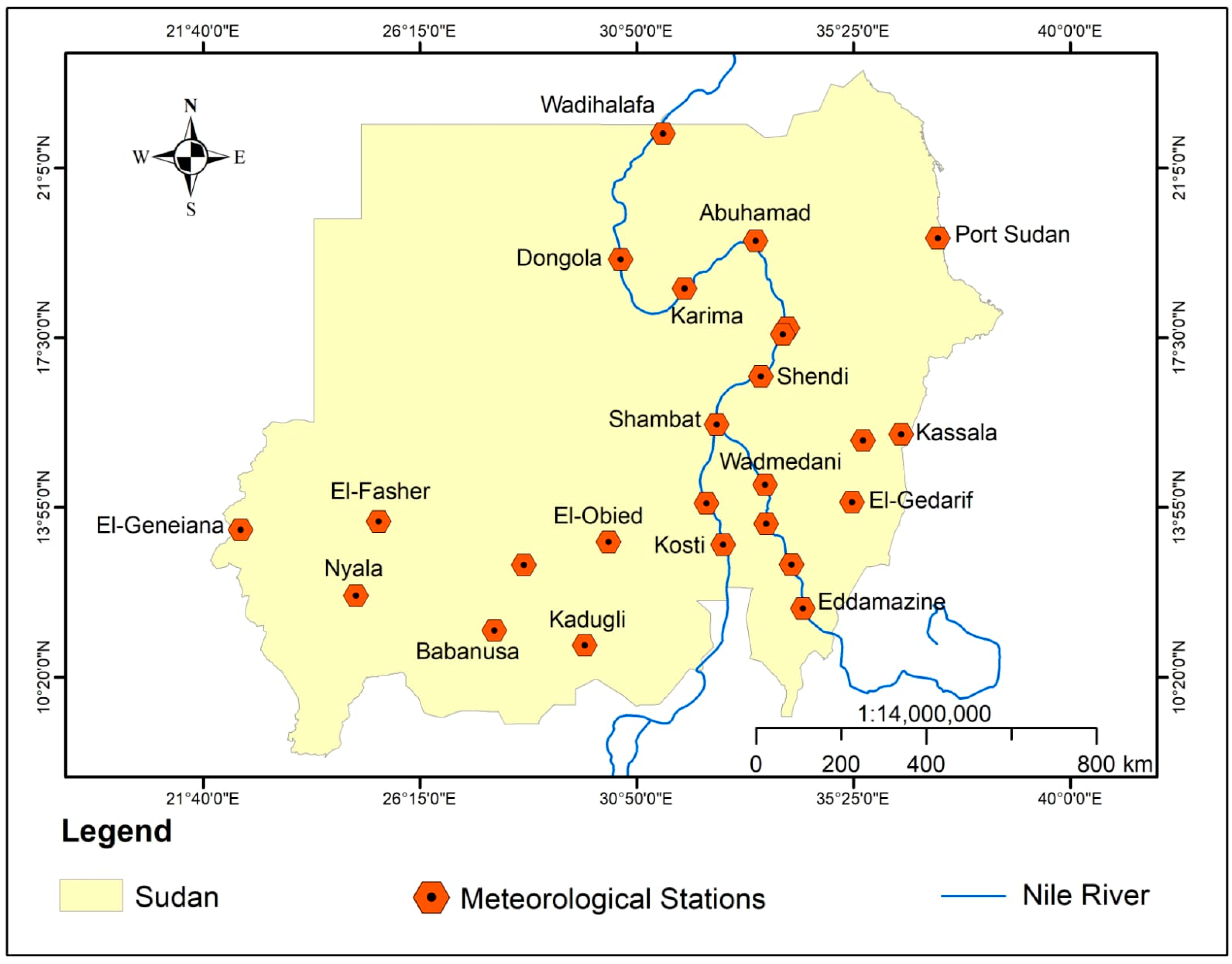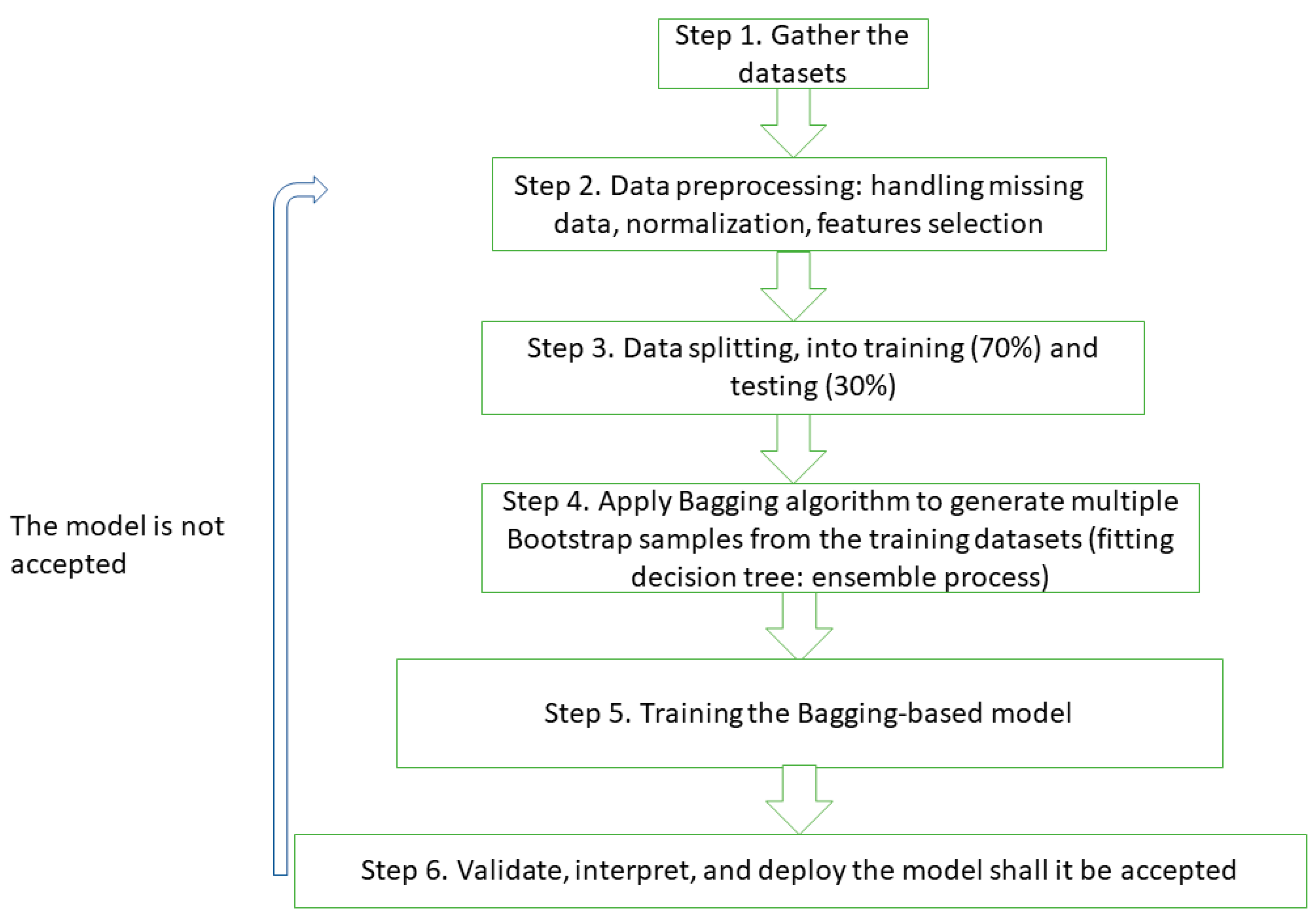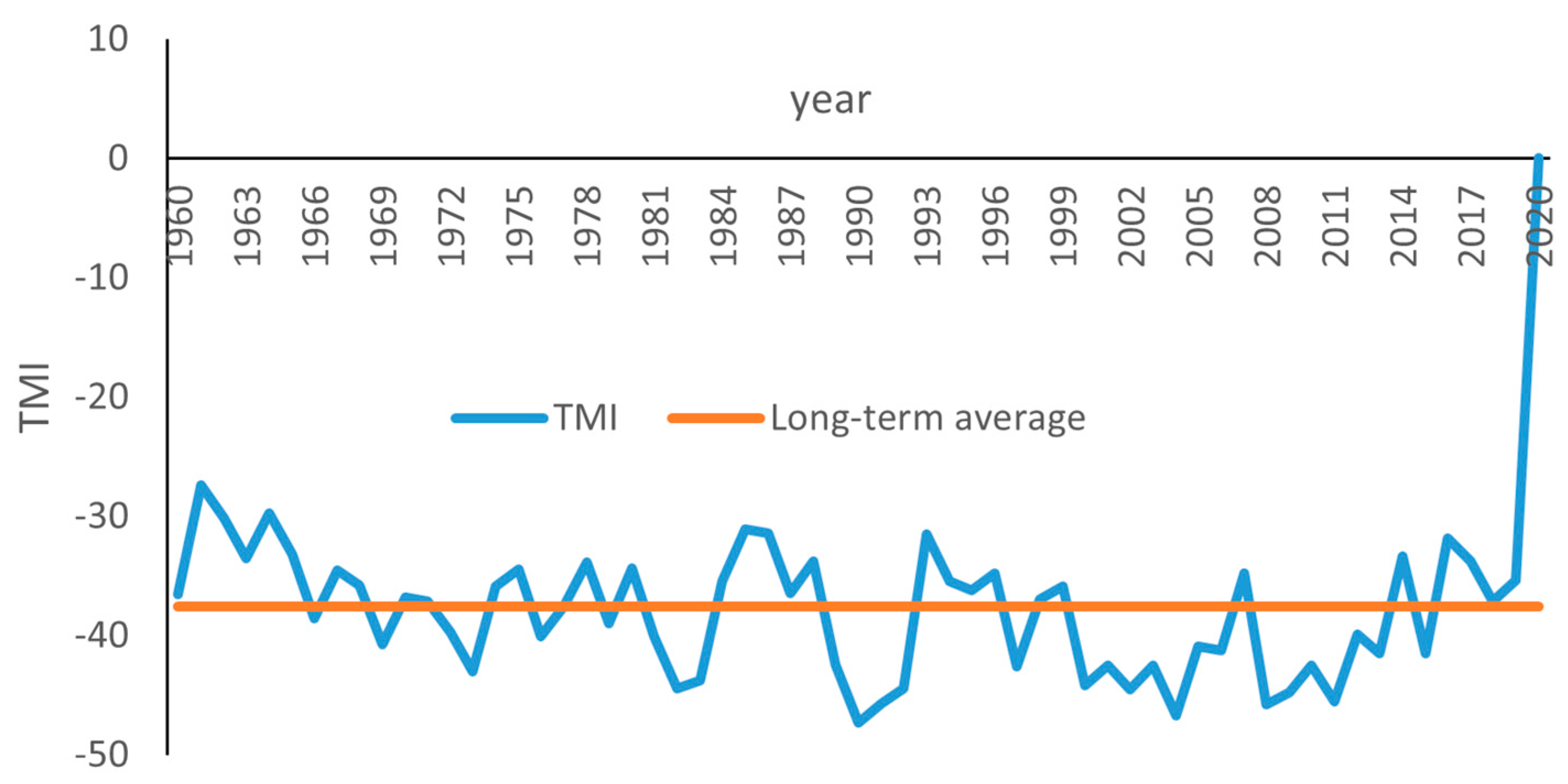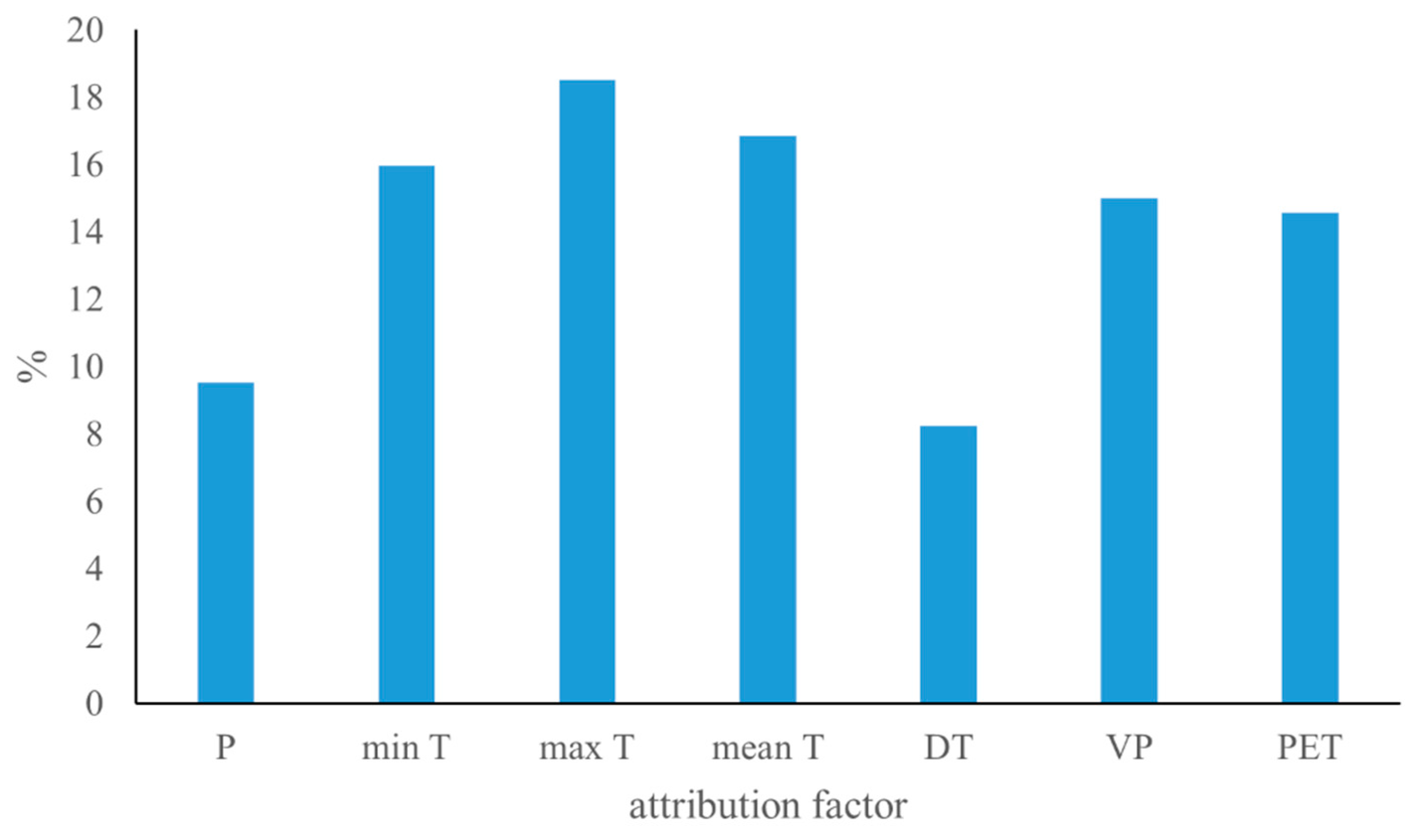A Deeper Understanding of Climate Variability Improves Mitigation Efforts, Climate Services, Food Security, and Development Initiatives in Sub-Saharan Africa
Abstract
:1. Introduction
2. Materials and Methods
2.1. Data Collection
2.2. Data Analysis
2.2.1. TMI Calculation
2.2.2. Trend Detection
2.2.3. Bagging Machine Learning Algorithm
2.2.4. Uncertainty
3. Results
3.1. Factors Influencing Climate Variability and Trend
3.2. Drought Detection and TMI Modeling
4. Discussion
4.1. Climate Variability
4.2. Climate Services
4.2.1. Runoff Management in SSA
4.2.2. Agroforestry
4.2.3. Filling Technical and Reliable Data Gaps
5. Conclusions
Supplementary Materials
Author Contributions
Funding
Data Availability Statement
Conflicts of Interest
References
- Shamseddin, M.A. Impacts of drought, food security policy and Climate change on performance of irrigation schemes in Sub-Saharan Africa: The case of Sudan. Agric. Water Manag. 2020, 232, 106064. [Google Scholar] [CrossRef]
- Ayansina, A.; Abimbola, O.; Oluwatoyin, S.; Marion, B.; Harald, S.; Patrick, S.; Margaret, O.; Lemlem, F.; Adefunke, F. Extreme climate events in sub-Saharan Africa: A call for improving agricultural technology transfer to enhance adaptive capacity. Clim. Serv. 2022, 27, 100311. [Google Scholar] [CrossRef]
- Ekolu, J.; Bastien, D.; Moussa, S.; Jonathan, M.; Yves, T.; Gabriele, V.; Dhais, P.; Gil, M.; Jean-Emmanuel, P.; Charles, O.; et al. Long-term variability in hydrological droughts and floods in sub-Saharan Africa: New perspectives from a 65-year daily streamflow dataset. J. Hydrol. 2022, 613, 128359. [Google Scholar] [CrossRef]
- Ekolu, J.; Bastien, D.; Yves, T.; Gabriele, V.; Louise, J.; Gil, M.; Jean-Emmanuel, P.; Jonathan, M.; Simon, M.; Moussa, S.; et al. Variability in flood frequency in sub-Saharan Africa: The role of large-scale climate modes of variability and their future impacts. J. Hydrol. 2024, 640, 131679. [Google Scholar] [CrossRef]
- Lefe, Y.; Peter, A.; Aloysius, M.; Jonah, K.; Rejoice, R. Does climate variability matter in achieving food security in Sub-Saharan Africa? Environ. Chall. 2024, 15, 100870. [Google Scholar] [CrossRef]
- Omotoso, A.; Simon, L.; Kehinde, O.; Christopher, S.; Abiodun, O. Climate change and variability in sub-Saharan Africa: A systematic review of trends and impacts on agriculture. J. Clean. Prod. 2023, 414, 137487. [Google Scholar] [CrossRef]
- Zenda, M.; Rudolph, M.; Harley, C. The Impact of Climate Variability on the Livelihoods of Smallholder Farmers in an Agricultural Village in the Wider Belfast Area, Mpumalanga Province, South Africa. Atmosphere 2024, 15, 1353. [Google Scholar] [CrossRef]
- Shamseddin, M.A.; Elbushra, A.A.; Ahmed, A.E.; Elmesski, A.; Osman, K. Climate variability impacts on crop yields and agriculture contributions to gross domestic products in the Nile basin (1961–2016): What did deep machine learning algorithms tell us? Theor. Appl. Clim. 2024, 155, 3951–3968. [Google Scholar] [CrossRef]
- Lu, T.; Wenmin, Z.; Christin, A.; Stéphanie, H.; Martin, B.; Ke, H.; Rasmus, F. Changes in vegetation-water response in the Sahel-Sudan during recent decades. J. Hydrol. Reg. Stud. 2024, 52, 101672. [Google Scholar] [CrossRef] [PubMed]
- Tefera, A.S.; Siyum, Z.G.; Berhe, D.H.; Gebru, B. Impact of climate variability and environmental policies on vegetation dynamics in the semi-arid Tigray. Discov. Environ. 2024, 2, 6. [Google Scholar] [CrossRef]
- IPCC. Climate Change 2022: Impacts, Adaptation, and Vulnerability; Contribution of Working Group II to the Sixth Assessment Report of the Intergovernmental Panel on Climate Change; Pörtner, H.-O., Roberts, D.C., Tignor, M., Poloczanska, E.S., Mintenbeck, K., Alegría, A., Craig, M., Langsdorf, S., Löschke, S., Möller, V., et al., Eds.; Cambridge University Press: Cambridge, UK; New York, NY, USA, 2022; 3056p. [Google Scholar] [CrossRef]
- Bhaga, T.; Dube, T.; Shekede, M.D.; Shoko, C. Impacts of Climate Variability and Drought on Surface Water Resources in Sub-Saharan Africa Using Remote Sensing: A Review. Remote Sens. 2020, 12, 4184. [Google Scholar] [CrossRef]
- WMO. State of the Climate in Africa 2020 WMO-No 1275; World Meteorological Organization: Geneva, Switzerland, 2021; Available online: https://library.wmo.int/idurl/4/57682 (accessed on 26 November 2024).
- Shen, C.; Chen, X.; Laloy, E. Editorial: Broadening the Use of Machine Learning in Hydrology. Front. Water 2021, 3. [Google Scholar] [CrossRef]
- Molina, M.; O’Brian, T.; Anderson, G.; Ashfaq, M.; Bennett, K.; Collins, W.; Dagon, K.; Juan, M.; Ullrich, P. A Review of Recent and Emerging Machine Learning Applications for Climate Variability and Weather Phenomena. Artif. Intell. Earth Syst. 2023, 2. [Google Scholar] [CrossRef]
- Lalika, C.; Aziz, M.; Mturi, J.; Makarius, C. Machine learning algorithms for the prediction of drought conditions in the Wami River sub-catchment, Tanzania. J. Hydrol. Reg. Stud. 2024, 53, 101794. [Google Scholar] [CrossRef]
- Zhao, Y.; Zhang, J.; Bai, Y.; Zhang, S.; Yang, S.; Henchiri, M.; Seka, A.M.; Nanzad, L. Drought Monitoring and Performance Evaluation Based on Machine Learning Fusion of Multi-Source Remote Sensing Drought Factors. Remote Sens. 2022, 14, 6398. [Google Scholar] [CrossRef]
- Mosaffa, H.; Mojtaba, S.; Iman, M.; Mojtaba, N.; Jahromi, H. Application of machine learning algorithms in hydrology. In Computers in Earth and Environmental Sciences; Elsevier: Amsterdam, The Netherlands, 2022; pp. 585–591. [Google Scholar] [CrossRef]
- Kim, Y.-T.; Yu, J.-U.; Kim, T.-W.; Kwon, H.-H. A novel approach to a multi-model ensemble for climate change models: Perspectives on the representation of natural variability and historical and future climate. Weather Clim. Extrem. 2024, 44, 100688. [Google Scholar] [CrossRef]
- Altman, N.; Krzywinski, M. Ensemble methods: Bagging and random forests. Nat. Methods 2017, 14, 933–934. [Google Scholar] [CrossRef]
- Leng, G.; Hall, J. Predicting spatial and temporal variability in crop yields: An inter-comparison of machine learning, regression and process-based models. Environ. Res. Lett. 2020, 15, 044027. [Google Scholar] [CrossRef] [PubMed]
- Frohlich, C. Water: Reason for Conflict or Catalyst for Peace? The Case of the Middle East. Dans L’Europe en Formation 2012/3 (n° 365). Eur. Form. 2012, 3, 139–161. [Google Scholar] [CrossRef]
- Bromwich, B. Nexus meets crisis: A review of conflict, natural resources and the humanitarian response in Darfur with reference to the water–energy–food nexus. Int. J. Water Res. Dev. 2015, 31, 375–392. [Google Scholar] [CrossRef]
- Jacobs, K.; Street, R. The next generation of climate services. Clim. Serv. 2020, 20, 100199. [Google Scholar] [CrossRef]
- Harris, I.; Osborn, T.; Jones, P.; Lister, D. Version 4 of the CRU TS monthly high-resolution gridded multivariate climate dataset. Sci. Data 2020, 7, 109. [Google Scholar] [CrossRef]
- Huang, J.; Dool, H.; Georgarakos, K. Analysis of Model-Calculated Soil Moisture over the United States (1931–1993) and Applications to Long-Range Temperature Forecasts. J. Clim. 1996, 9, 1350–1362. [Google Scholar] [CrossRef]
- Sha, Z.; Yu, B. Physical basis of the potential evapotranspiration and its estimation over land. J. Hydrol. 2024, 641, 131825. [Google Scholar] [CrossRef]
- Pereira, A.R.; Pruitt, W.O. Adaptation of the Thornthwaite scheme for estimating daily reference evapotranspiration. Agric. Water Manag. 2004, 66, 251–257. [Google Scholar] [CrossRef]
- Karim, M.; Bikash, D.; Md Mizanur, R.; Nguyen, H. Thornthwaite moisture index and depth of suction change under current and future climate—An Australian study. J. Rock Mech. Geotech. Eng. 2024, 16, 1761–1775. [Google Scholar] [CrossRef]
- Karunarathne, A.; Gad, E.; Disfani, M.; Sivagnanasundram, S.; Wilson, J. Review of calculation procedures of Thornthwaite moisture index and its impact on footing design. Aust. Geomech. 2016, 51, 85–95. [Google Scholar]
- Marshall, M.; Funk, C.; Michaelsen, J. Examining evapotranspiration trends in Africa. Clim. Dyn. 2012, 38, 1849–1865. [Google Scholar] [CrossRef]
- González, S.; Salvador, G.; Javier, D.; Lior, R.; Francisco, H. A practical tutorial on bagging and boosting based ensembles for machine learning: Algorithms, software tools, performance study, practical perspectives and opportunities. Inf. Fusion 2020, 64, 205–237. [Google Scholar] [CrossRef]
- Fan, Y.; Dool, H. Climate Prediction Center global monthly soil moisture data set at 05° resolution for 1948 to present. J. Geophys. Res. Atmos. 2004, 109. [Google Scholar] [CrossRef]
- Mohamed, I.H.; Shamseddin, M.A.; Adil, D.M. Rainfed-based production of Megathyrsus maximus in sub-Saharan Africa: The case of the semi-arid environment of Sudan African. J. Range Forage Sci. 2022, 40, 247–256. [Google Scholar] [CrossRef]
- Starr, M.; Alam, S.A. Water balance of the Sudanese savannah woodland region. Hydrol. Sci. J. 2015, 60, 706–722. [Google Scholar] [CrossRef]
- Palmer, P.I.; Wainwright, C.M.; Dong, B.; Maidment, R.; Wheeler, K.; Gedney, N.; Hickman, J.; Madani, N.; Folwell, S.; Abdo, G.; et al. Drivers and impacts of Eastern African rainfall variability. Nat. Rev. Earth Environ. 2023, 4, 254–270. [Google Scholar] [CrossRef]
- Babaousmail, H.; Ayugi, B.O.; Onyutha, C.; Kebacho, L.L.; Ojara, M.; Ongoma, V. Analysis of Changes in Rainfall Concentration over East Africa. Atmosphere 2023, 14, 1679. [Google Scholar] [CrossRef]
- Conway, D.; Persechino, A.; Ardoin-Bardin, S.; Hamandawana, H.; Dieulin, C.; Mahé, G. Rainfall and Water Resources Variability in Sub-Saharan Africa during the Twentieth Century. J. Hydrometeorol. 2009, 10, 41–59. [Google Scholar] [CrossRef]
- Kotikot, S.M.; Smithwick, E.; Greatrex, H. Observations of enhanced rainfall variability in Kenya, East Africa. Sci. Rep. 2024, 14, 12915. [Google Scholar] [CrossRef]
- Onyutha, C. Trends and variability of temperature and evaporation over the African continent: Relationships with precipitation. Atmósfera 2021, 34, 267–287. [Google Scholar] [CrossRef]
- Abiye, O.; Mathew, O.J.; Summonu, L.; Babatunde, O. Potential evapotranspiration trends in West Africa from 1906 to 2015. SN Appl. Sci. 2019, 1, 1434. [Google Scholar] [CrossRef]
- Gadallah, N.A.; Taha, I.S.; Hano, A.I.; Siddig, A.; Bo, H. Integrated Approach for Assessment and Monitoring of Forests Conditions in the Drylands of Sudan. Arid. Ecosyst. 2022, 12, 142–153. [Google Scholar] [CrossRef]
- Ogou, F.K.; Ojeh, V.N.; Naabil, E.; Mbah, C. Hydro-climatic and Water Availability Changes and its Relationship with NDVI in Northern Sub-Saharan Africa. Earth Syst. Environ. 2022, 6, 681–696. [Google Scholar] [CrossRef]
- Kumar, P.; Deka, D.; Yadav, A.; Kumar, M.; Das, J.; Singh, A.; Gurjar, A. Potential and actual evapotranspiration and Landsat derived indices. Glob. J. Environ. Sci. Manag. 2024, 10, 1227–1248. [Google Scholar] [CrossRef]
- Mohamed, A.; Alarifi, S.; Abdelrady, A. Sedimentary cover and structural trends affecting the groundwater flow in the Nubian Sandstone Aquifer System: Inferences from geophysical, field and geochemical data. Front. Earth Sci. 2023, 11, 1173569. [Google Scholar] [CrossRef]
- Lombe, P.; Elsa, C.; Paulo, R. Drought Dynamics in Sub-Saharan Africa: Impacts and Adaptation Strategies. Sustainability 2024, 16, 9902. [Google Scholar] [CrossRef]
- Sylla, M.B.; Elguindi, N.; Giorgi, F.; Wisser, D. Projected robust shift of climate zones over West Africa in response to anthropogenic climate change for the late 21st century. Clim. Change 2016, 134, 241–253. [Google Scholar] [CrossRef]
- Eltahir, E.A. A feedback mechanism in annual rainfall, Central Sudan. J. Hydrol. 1989, 110, 323–334. [Google Scholar] [CrossRef]
- Reliefweb. The Sudan: 2020 Flood Response Overview. 2020. Available online: https://www.google.com/url?sa=t&source=web&rct=j&opi=89978449&url=https://openknowledge.fao.org/server/api/core/bitstreams/0d0f41e0-ee2d-494c-9fa7-22792ba8b008/content&ved=2ahUKEwjXr5uV04iKAxXcwAIHHR9IAJkQFnoECB0QAQ&usg=AOvVaw3dONOyndD_Tn8VL_Z8ZBjy (accessed on 16 November 2024).
- Tambal, S.; Elsawahli, H.; Ibrahim, E.; Lumbroso, D. Increasing urban flood resilience through public participation: A case study of Tuti Island in Khartoum, Sudan. J. Flood Risk Manag. 2024, 17, e12966. [Google Scholar] [CrossRef]
- NASA. Record Flooding in Sudan. 2020. Available online: https://earthobservatory.nasa.gov/images/147288/record-flooding-in-sudan (accessed on 16 November 2024).
- Schunke, J.; Laux, P.; Bliefernicht, J.; Waongo, M.; Sawadogo, W.; Kunstmann, H. Exploring the Potential of the Cost-Efficient TAHMO Observation Data for Hydro-Meteorological Applications in Sub-Saharan Africa. Water 2021, 13, 3308. [Google Scholar] [CrossRef]
- Yang, Y.; Tong, X. Spatial variability and uncertainty associated with soil moisture content using INLA-SPDE combined with PyMC3 probability programming. Sci. Rep. 2024, 14, 23900. [Google Scholar] [CrossRef] [PubMed]
- Nooni, I.K.; Hagan, D.F.T.; Wang, G.; Ullah, W.; Li, S.; Lu, J.; Bhatti, A.S.; Shi, X.; Lou, D.; Prempeh, N.A.; et al. Spatiotemporal Characteristics and Trend Analysis of Two Evapotranspiration-Based Drought Products and Their Mechanisms in Sub-Saharan Africa. Remote. Sens. 2021, 13, 533. [Google Scholar] [CrossRef]
- Higginbottom, T.P.; Adhikari, R.; Dimova, R.; Redicker, S.; Foster, T. Performance of large-scale irrigation projects in sub-Saharan Africa. Nat. Sustain. 2021, 4, 501–508. [Google Scholar] [CrossRef]
- You, L. Africa infrastructure country diagonsitic. In Irrigation Investment Needs in Sub-Saharan Africa; The World Bank: Washington, DC, USA, 2008. [Google Scholar]
- Yesuf, M.; Salvatore, D.; Temesgen, D.; Claudia, R.; Gunnar, K. The Impact of Climate Change and Adaptation on Food Production in Low-Income Countries, Evidence from the Nile Basin, Ethiopia, IPFRI—Social Science. 2008. Available online: https://www.ifpri.org/publication/impact-climate-change-and-adaptation-food-production-low-income-countries (accessed on 26 November 2024).
- Kusangaya, S.; Michele, L.; Emma, A.; Graham, P. Impacts of climate change on water resources in southern Africa: A review. Phys. Chem. Earth Parts A/B/C 2014, 67–69, 47–54. [Google Scholar] [CrossRef]
- Brullo, T.; Barnett, J.; Waters, E.; Boulter, S. The enablers of adaptation: A systematic review. npj Clim. Action 2024, 3, 40. [Google Scholar] [CrossRef]
- Shamseddin, M.A. Climatic Change Impacts on Growing Degree Days and Climatologically Suitable Cropping Areas in the Eastern Nile Basin. Agric. Res. 2021, 10, 72–82. [Google Scholar] [CrossRef]
- Mangani, T.; Mangani, R.; Chirima, G.; Khomo, L.; Truter, W. Using mulching to reduce soil surface temperature to facilitate grass production. Heliyon 2022, 8, e12284. [Google Scholar] [CrossRef]
- Brown, S.; Miller, D.; Ordonez, P.; Baylis, K. Evidence for the impacts of agroforestry on agricultural productivity, ecosystem services, and human well-being in high-income countries: A systematic map protocol. Environ. Evid. 2018, 7, 24. [Google Scholar] [CrossRef]
- Iqbal, R.; Raza, M.; Valipour, M.; Saleem, M.; Zaheer, M.; Ahmad, S.; Toleikiene, M.; Haider, I.; Aslam, M.; Nazar, M. Potential agricultural and environmental benefits of mulches—A review. Bull. Natl. Res. Cent. 2020, 44, 75. [Google Scholar] [CrossRef]
- Wanderley, N.; Domingues, R.; Joly, C.A. Relationship between land surface temperature and fraction of anthropized area in the Atlantic forest region, Brazil. PLoS ONE 2019, 14, e0225443. [Google Scholar] [CrossRef] [PubMed]
- Zeratsion, B.T.; Manaye, A.; Gufi, Y.; Tesfayec, M.; Werku, A.; Anjulo, A. Agroforestry practices for climate change adaptation and livelihood resilience in drylands of Ethiopia. For. Sci. Technol. 2023, 20, 47–57. [Google Scholar] [CrossRef]
- Fjelde, H.; von Uexkull, N. Climate triggers: Rainfall anomalies, vulnerability and communal conflict in Sub-Saharan Africa. Political Geogr. 2012, 31, 444–453. [Google Scholar] [CrossRef]
- Andrew, T.; Letticia, K.; George, N.; Ronald, M. Evaluating effects of selected water conservation techniques and manure on sorghum yields and rainwater use efficiency in dry region of Zimbabwe. Heliyon 2024, 10, e33032. [Google Scholar] [CrossRef]
- Tolossa, T.; Abebe, F.; Girma, A.; Yildiz, F. Review: Rainwater harvesting technology practices and implication of climate change characteristics in Eastern Ethiopia. Cogent Food Agric. 2020, 6, 1724354. [Google Scholar] [CrossRef]
- Chipomho, J.; Moreblessing, C.; Makore, F.; Cosmas, P. Rainwater Harvesting Technologies and Soil Moisture Conservation in Marginalised Semi-Arid Soils of Southern Africa. In The Marginal Soils of Africa; Nciizah, A.D., Roopnarain, A., Ndaba, B., Malobane, M.E., Eds.; Springer: Cham, The Netherlands, 2024. [Google Scholar] [CrossRef]
- Bennett, B.M.; Barton, G.A. The enduring link between forest cover and rainfall: A historical perspective on science and policy discussions. For. Ecosyst. 2018, 5, 5. [Google Scholar] [CrossRef]
- Shuai, M.; Zhou, S.; Yu, B.; Song, J. Deforestation-induced runoff changes dominated by forest-climate. feedbacks. Sci. Adv. 2024, 10, 3964. [Google Scholar] [CrossRef]
- Tefera, M.; Giovanna, S.; Alberto, C. Traditional In Situ Water Harvesting Practices and Agricultural Sustainability in Sub-Saharan Africa—A Meta-Analysis. Sustainability 2024, 16, 6427. [Google Scholar] [CrossRef]
- Alter, R.; Im, E.S.; Eltahir, E. Rainfall consistently enhanced around the Gezira Scheme in East Africa due to irrigation. Nat. Geosci. 2015, 8, 763–767. [Google Scholar] [CrossRef]
- Chiturike, P.; Gotosa, J.; Nyakudya, W.; Madamombe, S.; Mandumbu, R.; Chirinda, N.; Kugedera, A.; Nyamadzawo, G. The effects of contour-based rainwater harvesting and integrated nutrient management on maize yields in semi-arid regions of Zimbabwe. CABI Agric. Biosci. 2024, 5, 41. [Google Scholar] [CrossRef]
- Bessah, E.; Donkor, E.; Raji, A.; Taiwo, O.; Ololade, O.; Strapasson, A.; Amponsah, S.; Agodzo, S. Factors affecting farmers’ decision to harvest rainwater for maize production in Ghana. Front. Water 2022, 4, 966966. [Google Scholar] [CrossRef]
- Nonvide, G. Exploring combined adaptation strategies to improve crop yield and smallholder farmers’ welfare. Clim. Dev. 2024, 1–13. [Google Scholar] [CrossRef]
- Nzeyimana, L.; Åsa, D.; Lotta, A.; Gyberg, V. Success and failure factors for increasing Sub-Saharan African smallholders’ resilience to drought through water management. Int. J. Water Resour. Dev. 2021, 39, 273–293. [Google Scholar] [CrossRef]
- Barry, B.; Olaleye, A.; Zougmoré, R.; Fatondji, D. Rainwater Harvesting Technologies in the Sahelian Zone of West Africa and the Potential for Outscaling; International Water Management Institute: Colombo, Sri Lanka, 2008; 40p. [Google Scholar]
- Ruticumugambi, J.A.; Kaplin, B.; Blondeel, H.; Mukuralinda, A.; Ndoli, A.; Verdoodt, A.; Rutebuka, J.; Imanirareba, E.; Uwizeyimana, V.; Gatesi, J.; et al. Diversity and composition of agroforestry species in two agro-ecological zones of Rwanda. Agrofor. Syst. 2024, 98, 1421–1443. [Google Scholar] [CrossRef]
- Quandt, A.; Neufeldt, H.; McCabe, T. Building livelihood resilience: What role does agroforestry play? Clim. Dev. 2018, 11, 485–500. [Google Scholar] [CrossRef]
- Octavia, D.; Murniati, S.; Hani, A.; Mindawati, N.; Suratman; Swestiani, D.; Junaedi, A.; Undaharata, N.; Santosa, P.; Wahyuningtyas, R.; et al. Smart agroforestry for sustaining soil fertility and community livelihood. For. Sci. Technol. 2023, 19, 315–328. [Google Scholar] [CrossRef]
- Tranchina, M.; Reubens, B.; Frey, M.; Mele, M.; Mantino, A. What challenges impede the adoption of agroforestry practices? A global perspective through a systematic literature review. Agrofor. Syst. 2024, 98, 1817–1837. [Google Scholar] [CrossRef]
- Kpoviwanou, M.; Bienvenue, S.; Christine, O. Challenges in adoption and wide use of agroforestry technologies in Africa and pathways for improvement: A systematic review. Trees For. People 2024, 17, 100642. [Google Scholar] [CrossRef]
- Muthee, K.; Duguma, L.; Majale, C.; Mucheru-Muna, M.; Wainaina, P.; Minang, P. A quantitative appraisal of selected agroforestry studies in the Sub-Saharan Africa. Heliyon 2022, 8, e10670. [Google Scholar] [CrossRef] [PubMed] [PubMed Central]
- Grovermann, C.; Rees, C.; Beye, A.; Wossen, T.; Abdoulaye, T.; Cicek, H. Uptake of agroforestry-based crop management in the semi-arid Sahel—Analysis of joint decisions and adoption determinants. Front. Sustain. Food Syst. 2023, 7. [Google Scholar] [CrossRef]
- Duffy, C.; Toth, G.; Cullinan, J.; Murray, U.; Spillane, C. Climate smart agriculture extension: Gender disparities in agroforestry knowledge acquisition. Clim. Dev. 2020, 13, 21–33. [Google Scholar] [CrossRef]
- Pavlidis, V.; Mahlatse, K.; Mxolisi, M.; Alexandridis, T.; Cherif, I.; Laneve, G.; Orsi, R.; Kartsios, S.; Chara Karypidou, M.; Sofiadis, I.; et al. A drought monitoring and early warning service for food security in South Africa. Clim. Serv. 2024, 34, 100463. [Google Scholar] [CrossRef]
- McCabe, G.J.; Wolock, D.M. Effects of climatic change and climatic variability on the Thornthwaite moisture index in the Delaware River basin. Clim. Change 1992, 20, 143–153. [Google Scholar] [CrossRef]
- Lamptey, B.; Sahabi Abed, S.; Gudoshava, M.; Mutemi, J.; Bopape, M.; Adefisan, E.; Igri, M.; Sanda, I.; Ndiaye, O.; Parker, D.; et al. Challenges and ways forward for sustainable weather and climate services in Africa. Nat. Commun. 2024, 15, 2664. [Google Scholar] [CrossRef] [PubMed]







| Variable | PET | P | Tmin | Tmax | DT | Tmean | Vp | TMI | AET | R |
|---|---|---|---|---|---|---|---|---|---|---|
| PET | 1.0 | −0.2 | 0.8 | 0.9 | 0 | 0.8 | 0.7 | 0.0 | −0.1 | 0.2 |
| P | −0.2 | 1.0 | −0.2 | −0.2 | 0 | −0.2 | −0.2 | 0.0 | 0.2 | 0.1 |
| Tmin | 0.8 | −0.2 | 1.0 | 0.8 | −0.1 | 0.9 | 0.9 | 0.0 | 0.0 | 0.2 |
| Tmax | 0.9 | −0.2 | 0.8 | 1.0 | 0.1 | 0.9 | 0.8 | 0.0 | −0.1 | 0.2 |
| DT | 0.0 | 0.0 | −0.1 | 0.1 | 1.0 | 0.0 | −0.1 | 0.1 | −0.1 | 0.0 |
| Tmean | 0.8 | −0.2 | 0.9 | 0.9 | 0.0 | 1.0 | 0.8 | 0.0 | −0.1 | 0.2 |
| Vp | 0.7 | −0.2 | 0.9 | 0.8 | −0.1 | 0.8 | 1.0 | 0.0 | −0.1 | 0.2 |
| TMI | 0.0 | 0.0 | 0.0 | 0.0 | 0.1 | 0.0 | 0.0 | 1.0 | 0.0 | 0.0 |
| AET | −0.1 | 0.2 | −0.1 | −0.1 | −0.1 | −0.1 | −0.1 | 0.0 | 1.0 | 0.2 |
| R | 0.2 | 0.0 | 0.2 | 0.2 | 0.0 | 0.2 | 0.2 | 0.0 | 0.2 | 1.0 |
Disclaimer/Publisher’s Note: The statements, opinions and data contained in all publications are solely those of the individual author(s) and contributor(s) and not of MDPI and/or the editor(s). MDPI and/or the editor(s) disclaim responsibility for any injury to people or property resulting from any ideas, methods, instructions or products referred to in the content. |
© 2024 by the authors. Licensee MDPI, Basel, Switzerland. This article is an open access article distributed under the terms and conditions of the Creative Commons Attribution (CC BY) license (https://creativecommons.org/licenses/by/4.0/).
Share and Cite
Ahmed, S.M.; Dinnar, H.A.; Ahmed, A.E.; Elbushra, A.A.; Turk, K.G.B. A Deeper Understanding of Climate Variability Improves Mitigation Efforts, Climate Services, Food Security, and Development Initiatives in Sub-Saharan Africa. Climate 2024, 12, 206. https://doi.org/10.3390/cli12120206
Ahmed SM, Dinnar HA, Ahmed AE, Elbushra AA, Turk KGB. A Deeper Understanding of Climate Variability Improves Mitigation Efforts, Climate Services, Food Security, and Development Initiatives in Sub-Saharan Africa. Climate. 2024; 12(12):206. https://doi.org/10.3390/cli12120206
Chicago/Turabian StyleAhmed, Shamseddin M., Hassan A. Dinnar, Adam E. Ahmed, Azharia A. Elbushra, and Khalid G. Biro Turk. 2024. "A Deeper Understanding of Climate Variability Improves Mitigation Efforts, Climate Services, Food Security, and Development Initiatives in Sub-Saharan Africa" Climate 12, no. 12: 206. https://doi.org/10.3390/cli12120206
APA StyleAhmed, S. M., Dinnar, H. A., Ahmed, A. E., Elbushra, A. A., & Turk, K. G. B. (2024). A Deeper Understanding of Climate Variability Improves Mitigation Efforts, Climate Services, Food Security, and Development Initiatives in Sub-Saharan Africa. Climate, 12(12), 206. https://doi.org/10.3390/cli12120206






